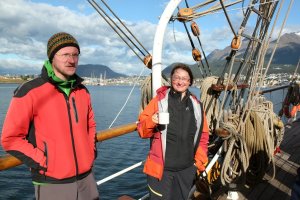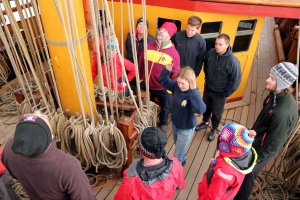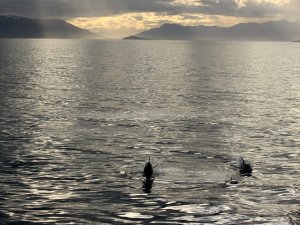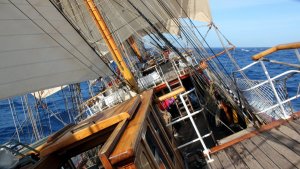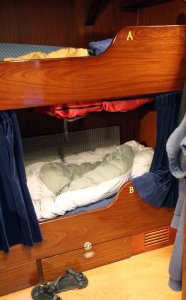Arto's Blog
| « Penguins, seals, lots of penguins | Sailing finished, but still on the road » |
First time on open sea
Posted: 2015-07-09 22:34:00, Categories: Travel, Chile, Argentina, Antarctica, Sailing, 875 words (permalink)We sailed out from Ushuaia in the morning of February 28th in beautiful, sunny weather. It was surprisingly windstill, especially in the morning. Later during the day a light breeze came from the west, the captain turned the engine off and we were moving quietly like sailing ships are designed to do, with just the wind pushing us forwards. We were on the Bark Europa, a hundred year old tall ship which sails to interesting destinations around the world.
Almost right away after departure started the first training sessions, to make us voyage crew instead of just passengers. One of our duties was to take turns at the lookout on the front deck, watching the sea in front and reporting small boats, icebergs or any other obstacles the ship might risk hitting. We learned how to steer the ship to a compass direction given by the captain and how to handle ropes when setting up or taking down sails. We even put on harnesses and climbed up to the mast, learning where to attach the safety line when working up there.
During the whole day and afternoon we stayed in the Beagle Channel, a relatively narrow passage leading out from Ushuaia to the Atlantic. Mostly we saw cliffs and mountains but there were also the town of Puerto Williams and a few smaller settlements on the south side. Many different birds, mainly albatrosses and petrels, were flying around the ship and in the evening a group of dolphins came to greet us. It was a pleasure to watch them dive under the ship and jump in the air on both sides very close to us.
Little by little the canal became wider, at the mouth of it were a few islands and then we were out in the open sea. It was the beginning of the Drake Passage between the southern tip of Chile and South Shetland islands, which are located a couple of hundred kilometers north of the Antarctic mainland. For Sandra and me it was the first time on a real ocean passage, with no land to see for several days.
The wind was relatively light but there was a continuous flow of relatively large waves, or swell as it is called, coming from the west. The waves were not sharp so they didn't strongly hit the sides or splash any water overboard, but made the ship rock back and forth, and roll from side to side. The wind itself came from a different direction, which made the movements seemingly random. There was no easy way of seeing in which direction and how deep the ship will bow at any given time, even when being outside and watching the waves. Inside it was of course still worse and within a few hours we both felt the first signs of seasickness.
During the following three days we struggled with being seasick, trying to still take part in the activities as much as we could. We took medication which helped a bit, but more important was to pay attention on what to do and not to do. Easiest was to lay in bed, as there the body doesn't try to be in control of the movements. Second best was to be outside and look at the waves or the horizon, and to sit in the deckhouse with large windows was mostly okay. Worst was to read a book or to do anything else which required looking down. The most difficult activities which we couldn't avoid were getting dressed in the cabin and using the bathroom. Nevertheless, we survived and even managed to attend to almost all the interesting lectures about wildlife and practical exercises about handling the sails, led by the permanent crew of the ship.
On the second and third day the wind picked up in speed and turned so that it was coming from more or less the same direction than the swell. It was still relatively light for the infamous Drake passage but a strong good wind for sailing. The waves became higher and water was running from side to side over the main deck. That was normal and nothing to fear about, the ship was taking the waves beautifully and felt secure. And although it was at times more tilted sideways than on the first day, the movements were more predictable. In short, it was behaving like a good sailing ship should. We still had an uneasy feeling in our stomachs but were slowly getting used to it.
On the fourth day of crossing the Drake passage the wind first turned to come from the south and later calmed down. The crew took down the sails with the help of us, the voyage crew (that's how the paying guests are called on Bark Europa) and the captain started the engine first time since Beagle Canal, if not counting the man overboard drill on the previous day. Not long afterwards we saw the first iceberg, a huge block of ice rising to a height of about 100 meters above the surface, and nobody knows how deep below it. Only a few miles further south were the first rocks belonging to the South Shetland islands, our first destination.
1 comment
Comment from: Andy Dodds
Good detail Arto, brings back happy memories, looking forward to the next chapter
2015-07-11 @ 11:02

Copyright Arto Teräs <ajt@iki.fi>, licensed under the Creative Commons Attribution-Share Alike 3.0 Unported License. (Unless otherwise mentioned in individual photos or other content.)
